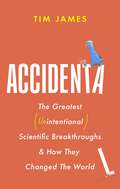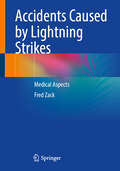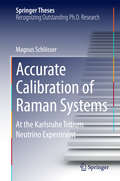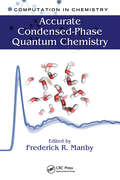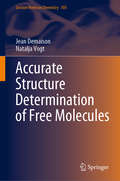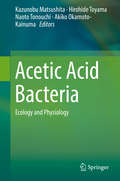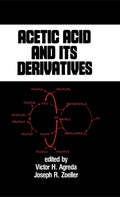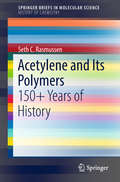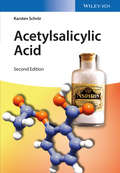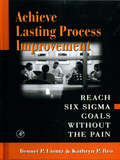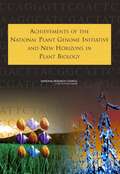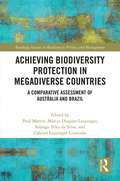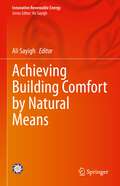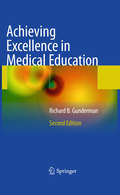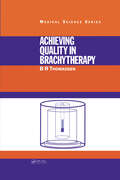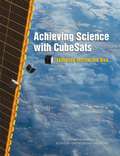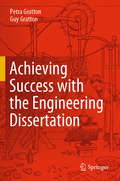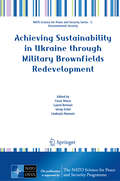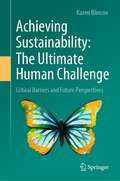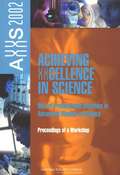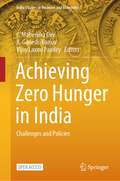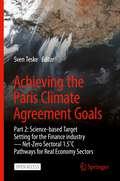- Table View
- List View
Accidental: The Greatest (Unintentional) Science Breakthroughs and How They Changed The World
by Tim James'Who said science was dry? Certainly not Tim James' New York Post 'James writes with infectious enthusiasm and optimism' Kirkus Reviews 'A science teacher by profession, Mr. James knows how to get his audience's attention' Wall Street Journal 'Humorous, yet deep' Professor Charles AntoineA rip-roaring adventure through science gone wrong, and accidentally changing humanity (mostly) for the better.We may imagine that science is a process of breakthroughs and light bulb moments. But in reality, science goes wrong 99% of the time.Almost every idea a scientist comes up with is quickly disproved by a failed experiment or rival research. Science moves at a rate of inches per decade and we often like it that way. But occasionally, just occasionally, a complete fluke happens and changes everything as we know it. From an untimely sneeze in a petri dish leading to the groundbreaking creation of antibiotics, to the incredible discovery of microwaves via melted chocolate, Accidental is a rip-roaring adventure through science gone wrong, and accidentally changing humanity for the better.
Accidents Caused by Lightning Strikes: Medical Aspects
by Fred ZackThe book presents relevant medical aspects of accidents caused by lightning strikes in a practical manner and is supported by case examples: from the fundamentals of energy transfer to emergency medical first aid, the treatment of sequelae, and the medical examination of the deceased. It is aimed at physicians of all specialties who are involved in the acute care or follow-up of individuals after lightning strike accidents, such as those from emergency medicine, legal medicine, intensive care, and general medicine.
Accidents May Happen
by Charlotte JonesFrom Wheaties to telephones, microwave ovens to yo-yos, here are the inspiring and often funny stories of 50 mistakes and misunderstandings that helped bring about life as we know it. With hilarious cartoons and wacky facts, this fascinating compendium illustrates the adage "If you don't learn from your mistakes, there's no sense making them."From the Trade Paperback edition.
Accretion Processes In Astrophysics
by Ignacio González MartÍnez-PaÍs Tariq Shahbaz Jorge Casares VelázquezIt has been more than fifty years since the first significant paper on accretion flows was written. In recent years, X-ray satellites capable of identifying accretion disks and radiation jets – indications that accretion has taken place – have significantly advanced our understanding of these phenomena. This volume presents a comprehensive and up-to-date introduction to the major theoretical and observational topics associated with accretion processes in astrophysics. Comprising lectures presented at the twenty-first Winter School of the Canary Islands Institute of Astrophysics, the text emphasises the physical aspects of accretion, investigating how radiation jets are produced, how accretion power is divided between jets and radiated energy, the geometry of accretion flow, and the accretion processes of active galactic nuclei. Written by an international team of experienced scientists, chapters offer young researchers key analytical tools for supporting and carrying out the next generation of front-line research.
Accurate Calibration of Raman Systems: At the Karlsruhe Tritium Neutrino Experiment (Springer Theses)
by Magnus SchlösserNeutrinos can arguably be labeled as the most fascinating elementary particles known as their small but non-zero rest mass points to new mass generating mechanisms beyond the Standard Model, and also assigns primordial neutrinos from the Big Bang a distinct role in shaping the evolution of large-scale structures in the universe. The open question of the absolute neutrino mass scale will be addressed by the Karlsruhe Tritium Neutrino (KATRIN) experiment, currently under construction. This thesis reports major contributions to developing and implementing new laser-spectroscopic precision tools to continuously monitor the isotope content of the windowless gaseous tritium source of KATRIN. The method of choice, Raman spectroscopy, is ideally suited for in-situ monitoring of all six hydrogen isotopologues. In a series of beautiful experiments the author obtained two independent novel calibration methods, first based on a comparison of experimental Raman depolarization ratios with corresponding quantum-chemical calculations, and second on a gas sampling technique. Both methods yield consistent cross-calibration results and, as well as yielding improvements in precision, will be of major importance in reducing systematic effects in long-term neutrino mass measurements. The methods developed in this thesis also have great potential to further broaden the applications of Raman spectroscopy to study extended sources such as in atmospheric physics.
Accurate Condensed-Phase Quantum Chemistry (Computation in Chemistry)
by Frederick R. ManbyThe theoretical methods of quantum chemistry have matured to the point that accurate predictions can be made and experiments can be understood for a wide range of important gas-phase phenomena. A large part of this success can be attributed to the maturation of hierarchies of approximation, which allow one to approach very high accuracy, provided t
Accurate Structure Determination of Free Molecules (Lecture Notes in Chemistry #105)
by Natalja Vogt Jean DemaisonThis book presents a detailed look at experimental and computational techniques for accurate structure determination of free molecules. The most fundamental property of a molecule is its structure – it is a prerequisite for determining and understanding most other important properties of molecules. The determination of accurate structures is hampered by a myriad of factors, subjecting the collected data to non-negligible systematic errors. This book explains the origin of these errors and how to mitigate and even avoid them altogether. It features a detailed comparison of the different experimental and computation methods, explaining their interplay and the advantages of their combined use. Armed with this information, the reader will be able to choose the appropriate methods to determine – to a great degree of accuracy – the relevant molecular structure.
Acetic Acid Bacteria: Ecology and Physiology
by Kazunobu Matsushita Hirohide Toyama Naoto Tonouchi Akiko Okamoto-KainumaThis book provides all facets of acetic acid bacteria (AAB) and offers the future targets and directions of AAB research. It summarizes the distinctive physiological properties of AAB and the recent progress on AAB study, especially in the following five areas: 1) Molecular phylogeny and genome study of AAB; 2) Ecological features of AAB: interaction with plants, natural fermentation systems, and insects; 3) Physiological features and living strategies of AAB, including rapid oxidation ability, acid resistance, biofilm formation, and genetic instability; 4) Molecular mechanisms of several oxidative fermentations such as acetate fermentation, sorbose fermentation, and ketogluconate fermentation; 5) Recent biotechnological aspects of AAB: biocatalysts, biosensors, biocellulose, and other useful polysaccharides. AAB research has a long history since the discovery of AAB by Louis Pasteur and the identification of AAB by Martinus Beijerinck in the nineteenth century. In the twentieth century, basic research on the taxonomic study of AAB and on biochemical study for the unique oxidative reactions of AAB had progressed as well as the industrial application of AAB not only in vinegar fermentation but also in the bioconversion process for useful chemical or pharmaceutical products. Entering the twenty-first century, AAB research has expanded more, and further progress is expected to be seen in all fields of AAB: classification and ecology, physiology and biochemistry, genetics, and biotechnology of vinegar fermentation and other oxidative fermentations. Far-reaching development in the last decade makes these bacteria more valuable for various industrial uses. Readers can obtain useful and comprehensive information which is exciting in aspects of basic science and provides hints for the better application of these bacteria to various kinds of practical production scenarios as well.
Acetic Acid and its Derivatives
by Victor H. Agreda Joseph R. ZoellerStriking a balance between basic chemistry and chemical engineering, this up-to-date reference discusses important aspects of acetic acid and its major derivatives, including chemistry, methods of preparation and manufacture, and synthesis, as well as current and emerging downstream technologies.;The book provides comprehensive physical property da
Acetylene and Its Polymers: 150+ Years of History (SpringerBriefs in Molecular Science)
by Seth C. RasmussenThis Brief presents for the first time a detailed historical overview of the development of acetylene polymers, beginning with the initial discovery of acetylene in 1836 and continuing up through the 2000 Nobel Prize in Chemistry. The polymerization of acetylene is most commonly associated with polyacetylene, which was found to be conductive when treated with oxidizing agents such as Br2 or I2 in the mid‐to‐late 1970s. In fact, under the right conditions, oxidized polyacetylenes can exhibit conductivities into the metallic regime, thus providing the first example of an organic polymer exhibiting metallic conductivity. As a consequence, the 2000 Nobel Prize in Chemistry was awarded to Hideki Shirakawa, Alan MacDiarmid, and Alan Heeger for this pioneering research, the award citation reading “for the discovery and development of electrically conductive polymers.” Because of this, most incorrectly view polyacetylene, as well as conducting polymers in general, to originate in the 1970s. In this work, the author examines the polymerization of acetylene from early thermal polymerization studies to the ultimate production of the fully conjugated polyacetylene. Although true polyacetylene was not successfully produced until the 1950s by Giulio Natta, the polymerization of acetylene dates back to 1866 with the work of Marcellin Berthelot. These initial efforts were continued by a range of scientists to produce a polymeric material collectively given the name cuprene in 1900 by Paul Sabatier. Between the initial cuprene studies and the production of true polyacetylene, two related materials were also studied, usually referred to as polyenes and polyvinylenes. Although both of these materials could be thought of as forms of polyacetylene, neither was actually generated from the direct polymerization of acetylene. Readers will gain insight into the fact that polyacetylene and conducting organic polymers have a much longer history than commonly believed and involved the work of a significant number of Nobel Laureates.
Acetylsalicylic Acid
by Karsten SchrörWritten by a leading expert on Aspirin-related research, this is the first comprehensive treaty of the history, pharmacological effects and clinical applications of one of the most successful drugs ever. The text is written with a wide audience in mind, and to be readily understandable for clinicians, pharmacists, biomedical researchers and pharmacologists alike. This second, completely revised edition contains the latest results of clinical and pharmacological research on Acetylsalicylic acid, addressing the multiple pharmacological properties of this famous drug with a balanced view on their translation into clinical practice, including prevention from cardiovascular diseases and colorectal cancer.
Achieve Lasting Process Improvement
by Bennet Lientz Kathryn ReaMethods of improving business processes are developed on an ongoing basis, but few are successful. Common problems encountered include the failure of processes to meet expectations and the inability to sustain or replicate these business processes. Involvement of personnel at grassroots level, as well as at management level, is essential in implementing effective process improvement methods. The authors present a step-by-step approach to the issue of effective process improvement, offering more than 200 tips and guidelines as well as addressing specific common problems and issues. The strategy presented is to take a broad and intuitive, but learned view of process improvement methods, and the tactics expounded are based on guidelines, common faults, and lessons learned. The authors disparage process improvement operations that depend on jargon and the support of just upper management, and promote grassroots involvement and self-sustaining measurement, making this an essential guide for all with involvement in process improvement.
Achievements Of The National Plant Genome Initiative And New Horizons In Plant Biology
by National Research Council of the National AcademiesLife on Earth would be impossible without plants. Humans rely on plants for most clothing, furniture, food, as well as for many pharmaceuticals and other products. Plant genome sciences are essential to understanding how plants function and how to develop desirable plant characteristics. For example, plant genomic science can contribute to the development of plants that are drought-resistant, those that require less fertilizer, and those that are optimized for conversion to fuels such as ethanol and biodiesel. The National Plant Genome Initiative (NPGI) is a unique, cross-agency funding enterprise that has been funding and coordinating plant genome research successfully for nine years. Research breakthroughs from NPGI and the National Science Foundation™ (NSF) Arabidopsis 2010 Project, such as how the plant immune system controls pathogen defense, demonstrate that the plant genome science community is vibrant and capable of driving technological advancement. This book from the National Research Council concludes that these programs should continue so that applied programs on agriculture, bioenergy, and others will always be built on a strong foundation of fundamental plant biology research.
Achieving Biodiversity Protection in Megadiverse Countries: A Comparative Assessment of Australia and Brazil (Routledge Studies in Biodiversity Politics and Management)
by Paul Martin Márcia Dieguez Leuzinger Solange Teles da Silva Gabriel Leunziger CoutinhoThis volume systematically analyses why legal doctrines for the protection of biodiversity are not sufficiently effective. It examples implementation in Australia and Brazil, two megadiverse countries with very differing legal and cultural traditions and natural environments. Substantial effort goes into the development and interpretation of legal doctrines for the protection of biodiversity in national and international law. Despite this, biodiversity continues in steep decline. Nowhere is this more evident than in megadiverse countries, such as Australia and Brazil, which possess the greatest number and diversity of animals and plants on Earth. The book covers a wide range of topics, including farming, mining, marine environments, indigenous interests and governance. Achieving Biodiversity Protection in Megadiverse Countries highlights specific causes of underperformance in protecting diverse terrestrial and marine environments. It provides proposals for more effective implementation in these two jurisdictions, relevant to other megadiverse territories, and for biodiversity protection generally. Each chapter was written by teams of Australian and Brazilian authors, so that similar issues are considered across both jurisdictions, to provide both country-specific and generalisable insights. Achieving Biodiversity Protection in Megadiverse Countries will be of great interest to students and scholars of environmental law and governance and biodiversity conservation, as well as policymakers, practitioners and NGOs working in these fields.
Achieving Building Comfort by Natural Means (Innovative Renewable Energy)
by Ali SayighAchieving Building Comfort by Natural Means explores examples of green building designs and methods that are currently being used around the world to achieve human comfort in buildings. The operation of buildings accounts for more than 40% of total energy use and is a major source of carbon emissions. It is imperative that this consumption be substantially decreased and that energy needed for building comfort is obtained from renewable and environmentally friendly sources. This book brings together a global group of contributors who look at factors such as location, climate, building materials, energy management, ventilation, thermal environmental conditions, shading, lighting, acoustics, and more that are critical for achieving buildings that are more sustainable.Thermal comfort and climatic potential of ventilative cooling in Italian climates is available open access under a Creative Commons Attribution 4.0 International License via link.springer.com.
Achieving Excellence in Medical Education: Second Edition
by Richard B. GundermanA goldmine of theoretical insights and practical suggestions, Achieving Excellence in Medical Education, Second Edition explores the essential question facing medical educators and learners today: What is our vision of educational excellence, and what can we do to enhance our performance? Among the topics explored within this updated, engaging, informative, and thought-provoking text are: * Education's position as a priority of medical schools * Seminal educational insights from non-medical educators * Best practices of outstanding educators and learners * Promises and pitfalls of new educational technologies * Key resources for promoting excellence in medical education * Medical education's role in preparing future leaders * Leadership roles for medical schools in universities and society Reviews of the first edition: "This is an eloquent, quotable, and inspirational book that provides a template for "Achieving Excellence in Medical Education." - Journal of the American Medical Association "Gunderman is an accomplished educator, well known as a thoughtful and provocative teacher. . . I recommend his book to department chairs, clerkship and residency program directors, and education professionals who are shaping the future of medical education." - New England Journal of Medicine
Achieving QTS
by John Sharp Jenny ByrneThis book supports trainees on primary initial teacher training courses where a secure knowledge and understanding of science is required for the award of Qualified Teacher Status (QTS). A rigorous test enables trainees to identify their strengths and weaknesses in science and this can be revisited in order to monitor and evaluate progress towards QTS. Trainees are able to direct their studies more usefully and quickly develop confidence in topics they find difficult. This edition is fully up to date with the 2007 QTS Standards.
Achieving Quality in Brachytherapy (Series in Medical Physics and Biomedical Engineering)
by B.R. ThomadsenAchieving Quality in Brachytherapy addresses the main issues that often prevent correct delivery of brachytherapy treatment. The book explains how to set up a functional quality assurance program in brachytherapy and covers all the steps needed to undertake particular treatment plans, from the initial planning required to the detailed specification
Achieving Science with CubeSats: Thinking Inside the Box
by Engineering Medicine National Academies of SciencesSpace-based observations have transformed our understanding of Earth, its environment, the solar system and the universe at large. During past decades, driven by increasingly advanced science questions, space observatories have become more sophisticated and more complex, with costs often growing to billions of dollars. Although these kinds of ever-more-sophisticated missions will continue into the future, small satellites, ranging in mass between 500 kg to 0.1 kg, are gaining momentum as an additional means to address targeted science questions in a rapid, and possibly more affordable, manner. Within the category of small satellites, CubeSats have emerged as a space-platform defined in terms of (10 cm x 10 cm x 10 cm)- sized cubic units of approximately 1.3 kg each called “U’s.” Historically, CubeSats were developed as training projects to expose students to the challenges of real-world engineering practices and system design. Yet, their use has rapidly spread within academia, industry, and government agencies both nationally and internationally. In particular, CubeSats have caught the attention of parts of the U.S. space science community, which sees this platform, despite its inherent constraints, as a way to affordably access space and perform unique measurements of scientific value. The first science results from such CubeSats have only recently become available; however, questions remain regarding the scientific potential and technological promise of CubeSats in the future. Achieving Science with CubeSats reviews the current state of the scientific potential and technological promise of CubeSats. This report focuses on the platform’s promise to obtain high- priority science data, as defined in recent decadal surveys in astronomy and astrophysics, Earth science and applications from space, planetary science, and solar and space physics (heliophysics); the science priorities identified in the 2014 NASA Science Plan; and the potential for CubeSats to advance biology and microgravity research. It provides a list of sample science goals for CubeSats, many of which address targeted science, often in coordination with other spacecraft, or use “sacrificial,” or high-risk, orbits that lead to the demise of the satellite after critical data have been collected. Other goals relate to the use of CubeSats as constellations or swarms deploying tens to hundreds of CubeSats that function as one distributed array of measurements.
Achieving Success with the Engineering Dissertation
by Guy Gratton Petra GrattonThis book guides the student reader in preparing their dissertation or major project, including both report and presentation, and explains how to use them as a bridge to the "next big thing" - the graduate's first job, or their next degree.The dissertation is the single most important component of an engineering degree, not only carrying the most marks, but bridging from academic study to professional practice. Achieving Success with the Engineering Dissertation describes the different types of dissertation, how to pick the best project and how a student can prepare themselves to succeed with their own dissertation. The authors explain how best to plan and execute the project, including the roles of the student, supervisor and project sponsor, and what they should expect from each other. Further material includes details of competitions that can be entered with dissertation projects, presentation of data, using the dissertation in job interviews, and creating research publications.Achieving Success with the Engineering Dissertation will be of use to both undergraduate and postgraduate students in all fields of Engineering, and to their supervisors.
Achieving Sustainability in Ukraine through Military Brownfields Redevelopment (NATO Science for Peace and Security Series C: Environmental Security)
by Cezar Morar Laurel Berman Serap Erdal Liudmyla NiemetsThis book is written by international experts who are brownfields practitioners from over 15 countries. Blighted and contaminated properties, including military, industrial, commercial, and multi-residential properties, globally referred to as “brownfields,” are a shared phenomenon among NATO and NATO-partner countries. They provide practical solutions to addressing, evaluating, and cleaning up brownfields, including multiple case studies. Topics include reuse of military brownfields, sustainable site reuse, community engagement, risk assessment, impacts of the war in Ukraine related to military brownfields development and redevelopment, a free training to improve capacity to evaluate environmental and health risks of brownfields, and shared best practices.
Achieving Sustainability: Critical Barriers and Future Perspectives
by Karen BlincoeThe book provides an assessment of whether sustainability is realizable in the current societal framework. What are the challenges and the barriers - and what are the levers necessary to meet and overcome them?Through a revision of the essence of sustainability the book provides an opportunity to understand the deeper level of the radical change that sustainability represents, and the resistance that is preventing its realization.To build the argument the sustainable development model is compared with current development theories as well as alternative solutions based on utopian models of the past. The book assesses the results that can be achieved within the current systemic framework, based on case stories. It outlines the limitations to sustainability, pointing out and defining the multiple, cross-sectoral and systemic barriers that hinder the transition.Finally, the book offers perspectives on achieving a sustainable future, encompassing the impacts from recent events including the pandemic as well as the multiple mitigation and transition initiatives undertaken globally.Brian Goodwin's QuoteLike the caterpillar that wraps itself up in its silken swaddling bands prior to its metamorphosis into a butterfly, we have wrapped ourselves in a tangled skin from which we can emerge only by going through a similarly dramatic transformation.
Achieving Xxcellence in Science: Role of Professional Societies in Advancing Women in Science
by Committee on Women in Science EngineeringThis report is the proceedings of a July 2002 workshop of the Committee on AXXS 2002: A Workshop for Clinical Societies to Enhance Women's Contributions to Science and their Profession. The workshop gathered representatives of clinical societies and identified ways to enhance the participation of women scientists in the clinical research workforce. This workshop was a follow-up to the AXXS 1999 conference sponsored by the Office of Research on Women's Health (ORWH) at the National Institutes of Health (NIH), which focused on how scientific societies could contribute to the enhancement of women's careers in science.
Achieving Zero Hunger in India: Challenges and Policies (India Studies in Business and Economics)
by S. Mahendra Dev A. Ganesh-Kumar Vijay Laxmi PandeyThis open access volume discloses rich set of findings and policy recommendations for India towards achieving the SDG 2.1 target of zero hunger by 2030. Through its fourteen chapters, it takes an integrated approach by examining diverse aspects of food and nutrition security through multidisciplinary lens of Agricultural Economics, Nutrition, Crop Sciences, Anthropology and Law, while being rooted in economics. The chapters reflect this diversity in disciplines in terms of the questions posed, the data sets used, and the methodologies followed. Starting from the evolution of policy response for hunger and nutrition security, the book covers aspects such gender budgeting, dietary diversity, women’s empowerment, calorie intake norms, socio-legal aspects of right to health, subjective wellbeing, bio-fortification, crop insurance and food security linkages, interdependence of public distribution system (for food security) and employment guarantee schemes especially during COVID-19 pandemic, effects of dairy dietary supplements, and so on. With its rich discussions, the book is compelling for students, researchers, policy makers, development professionals and practitioners working in areas of food and nutrition security, SDGs, in particular SDG1, SDG2 and SDG5, and sustainable food systems.
Achieving the Paris Climate Agreement Goals: Part 2: Science-based Target Setting for the Finance industry — Net-Zero Sectoral 1.5˚C Pathways for Real Economy Sectors
by Sven TeskeThis open access book is designed as a continuation of the editor’s 2019 book Achieving the Paris Climate Agreement Goals. This volume provides an in-depth analysis of industry sectors globally, and its purpose is to present emission reduction targets in 5-year steps (2025 to 2050) for the main twelve finance sectors per the Global Industry Classification System. This scientific analysis aims to support the United Nations Principles for Responsible Investment initiative to give sustainability guidance for the global finance industry. The industry sector pathways presented here are based on the latest global and regional 100% renewable energy and non-energy greenhouse gas Representative Concentration Pathways in order to keep climate change significantly under +1.5 C and thereby achieve the Paris Climate Agreement goals. The heart of this book is three chapters presenting the results of industry scenario modelling. These chapters cover twelve industry and service sectors as well as transportation and buildings. The specific energy demand and specific emissions are presented based on the emission accounting concept of “Scope 1, Scope 2 and Scope 3” emission pathways. This methodology has been developed to measure the climate and sustainability index for companies, and this research project expands the methodology to apply it to entire industry sectors. The results presented here are the first overall industry assessments under Scope 1, 2 and 3 from 2020 through 2050. The base for the energy pathways is the scenarios scenarios published in the previous volume. The nonenergy GHG emission scenarios, broken down to agriculture & forestry and industry, are detailed and include all major greenhouse gases and aerosols. The final section of the book presents the main conclusions of the industry pathway development work and recommendations for the finance industry and policy makers. Additionally, future qualitative future investment requirements in specific technologies and measures are presented.
